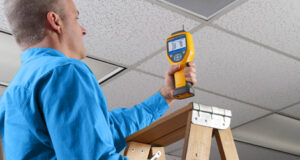Mold Removal Process Montreal
Mold is more than an aesthetic problem. There will need to be more than wiping and rigorous cleaning to solve the problem. Mold growth in your home or place of business is a systemic problem. As a result of this problem, mold can grow indoors. Condensation, leakage, humidity, poor circulation, high temperatures, floods, and other problems are common. Mold removal is only a band-aid treatment if the underlying issues are not addressed. Mold will return, creating health problems, diminishing the value of your home, and limiting productivity. To prevent additional injury, the problem must be addressed at its source. To survive, mold requires both moisture and a surface to grow on. Professionals and qualified specialists have completed thousands of Montreal mold inspections and removal operations.
Mold Inspection & Testing
Mold is more than simply an unappealing substance. It can be harmful to the health if swallowed or breathed. It can be challenging to contain and spreads quickly. By examining mold, you can mitigate its consequences by discovering a systemic therapy as soon as possible. Massive mold damage spreads and permanently destroys the ceiling, flooring, or walls. By inspecting your house for mold, you can fix the problem before it worsens and spreads across Montreal.
Consequently, you’ll spend less money defending yourself and your home. We take inspections very seriously. Because of our knowledge and equipment, we have a unique advantage over the competition in locating mold. We guarantee that all mold remnants will be removed from your home. Our competitors who supply both typically have their objectives. Our objective is to provide you with a dependable inspection at a reasonable price that does not conflict with our other services. However, we will suggest reliable, qualified, and reasonably priced professionals.

Mold Removal Process
Here are the following Six Essential Steps for Mold Removal in Montreal:
Mold Inspection
Qualified mold inspectors perform all of our inspections. We will do a comprehensive free visual inspection of your house, paying particular attention to places where mold has been known to develop.
Mold inspections comprise the following steps:
- Infrared Camera Scanning:
Infrared camera scanning is a valuable diagnostic tool for locating water leaks beneath floors, ceilings, and behind walls without inflicting any harm. It can also detect dew patches, warning of potential mold growth.
Moisture Meter:
A moisture meter helps detect moisture on surfaces such as walls and ceilings. Mold development is more common in conditions with high moisture content.

Air Quality Test:
A third party does an air quality test to assess the kind and degree of mold in your home (we may recommend a business if you prefer). Testing for air quality, sometimes called indoor air quality, determines the state of the air in a specific location. It has become prevalent in residential properties for landlords/tenants and when selling or purchasing a property. Air quality will be tested at commercial and industrial establishments in Montreal to ensure people work in a safe environment.
An air test may detect carbon dioxide, toxic vapors, dust, fungus, and ozone pollutants. Mold is the most commonly investigated contaminant. Air testing is utilized and valuable since it detects the type of mold particles and their individual spore levels, which is critical.
How is air quality testing done in Montreal?
While conducting an air test, at least two samples must be collected. Two examples are taken: one from the issue site and one from the outside or “controlled environment.” If there are many areas of concern, multiple samples must be collected. After the pieces are collected, they are forwarded to a facility in Montreal for analysis by specialists. The findings will be presented, and a report describing the various mold kinds and spore levels discovered will follow.
Mold is present if spores in the affected area are higher than those found outside or in a “controlled environment.”
If the report contains any of the following mold spore levels:
Elevated
Moderated
Not elevated
Detailed scope of work:
You will get a complete scope of work, an estimate, and the project manager’s conclusions within 24 to 48 hours of the inspection.
Final Third-Party Approval/What Can You Learn From a Mold Testing Report from a Third-Party?
- Mold Incidence in Controlled Environments
- Mold Species Found in Affected Rooms
- Mold Intensities in Affected Spaces
- Property Areas Affected by Mold and Requiring Removal
Work Needed to Complete a Mold Removal:
The mold eradication process in Toronto may be affected by several factors, which will be highlighted in this article. Property owners in Montreal may contact neighboring mold removal companies in Toronto after obtaining the mold testing results to return their property to a mold-free environment. Mold remediation entails considerably more than simply removing mold from the affected area.
That is the essential distinction property owners should make between mold removal and mold repair.
We’ve put up this step-by-step guide to help you understand what happens during mold remediation.
Evaluate and Isolate:
The first and most crucial stage in any mediation is to analyze the problem. A qualified mold removal expert (MRS) visits your building and decides on the following actions. This is the most critical moment to capture everything and call your insurance carrier. Then, they’ll check what caused the mold’s location and what may be hidden behind walls or ceilings. They’ll then use plastic or polyurethane sheeting to isolate the issue and restrict spore distribution to a minimum.
Put On Your Suit:
While it may appear to be something out of a Hollywood film, the unique protective gear mold remediation specialists use is for their general safety. At the very least, this comprises boots, goggles, and a respirator mask. This should not frighten you, but it is worth mentioning to demonstrate how dangerous breathing in mold spores may be.
Use Moisture to Control Dust:
Providing additional moisture to a mold-infested area may appear paradoxical, but it helps inhibit spores from spreading within the region. While the mold removal is ongoing, your professional may use a humidifier or other gear to generate an ambient mist.
Deconstruction of Affected Building Materials:
Building items contaminated by mold are removed at this stage of cleanup. This comprises plasterboard, carpeting, insulation, and other materials. The whole procedure is heavily controlled by EPA rules, which must be followed. Damaged products must be wrapped, sealed, and sprayed to remove concealed spores on the bag’s exterior. The cleanup crew then disposes of them appropriately.
Keeping the Area Clean:
Any items that cannot be removed are cleaned with a special brush and detergent solution-soaked wipes. This is one of the most challenging components of mold remediation and generally causes spores to be released into the air. All used cleaning instruments that cannot be disinfected must be disposed of according to the previous step’s requirements. If the HVAC system is harmed, professional tools and treatment procedures will be used to resolve any issues.
Contents Restore:
Though every property loss can potentially destroy specific goods, content restoration technology has improved to the point where many objects may be salvaged. A contents pack-out is usually performed around the start of the mold remediation procedure. A restoration business will remove salvageable things such as fabrics, clothing, hard goods, pictures, electronics, and other items and transport them off-site for repair. Some items cannot be preserved, while others can.
Biocide and Encapsulation Products:
The mold treatment team may apply a chemical known as a biocide to the whole space. The EPA has certified this liquid for killing mold spores. It must be set overnight before it is considered entirely adequate. The mold treatment crew will apply a mold-resistant coating encapsulating product to the afflicted area. This prevents mold from returning and prevents new infestations. Of course, this implies that the issue that caused the leak in the first place has been resolved, and moisture levels have returned to normal.
Sanitation of Egress Areas:
The crew next begins to remove and dispose of any plastic sheeting that has been placed between the afflicted area and the remainder of the structure. They’ll almost certainly utilize a HEPA-approved Hoover cleaner to guarantee that any spores that escaped during prior processes are destroyed.
Total Drying of the Area:
Your mold remediation and damage restoration firm will use dryers, fans, and other appliances to guarantee the space matches a specified humidity level to prevent mold from returning in the future. This is critical since the improper level might allow mold to grow back and negate the goal of the entire operation.
Clearance Testing After Remediation:
After that, a qualified mold remediation specialist will re-inspect the area. They will search for humidity, moisture levels, and visual signals to guarantee the mold problem is permanently resolved. They will also collect and analyze airborne spore samples from within and outside the remediated region. These are the actions that must be taken to determine whether or not the mold remediation was effective. Clearance testing verifies that mold remediation procedures are successful and that the remediated areas are safe for rebuilding and occupation.
Restoration:
Our Restoration Services experts will handle any rebuilding or restoration work required in your home or company.
Mold Remediation – Montreal:
Mold removal in Toronto is most easily detected by its intense, unique odor, which most people describe as earthy and musty. A mold infestation may not initially be an urgent worry for Greater Toronto Area property owners and managers. Most individuals will try cleaning off walls, tiles, and other surfaces with bleach or vinegar solutions to eliminate the patterned staining. To discover whether the material on your property is mold, contact us for mold testing and abatement.
Unfortunately, suppose specialist mold remediation is not conducted. In that case, mold will swiftly evolve, grow, and spread, polluting the air, the health of individuals living there, the building’s components, and even their things, such as clothing and furniture.
